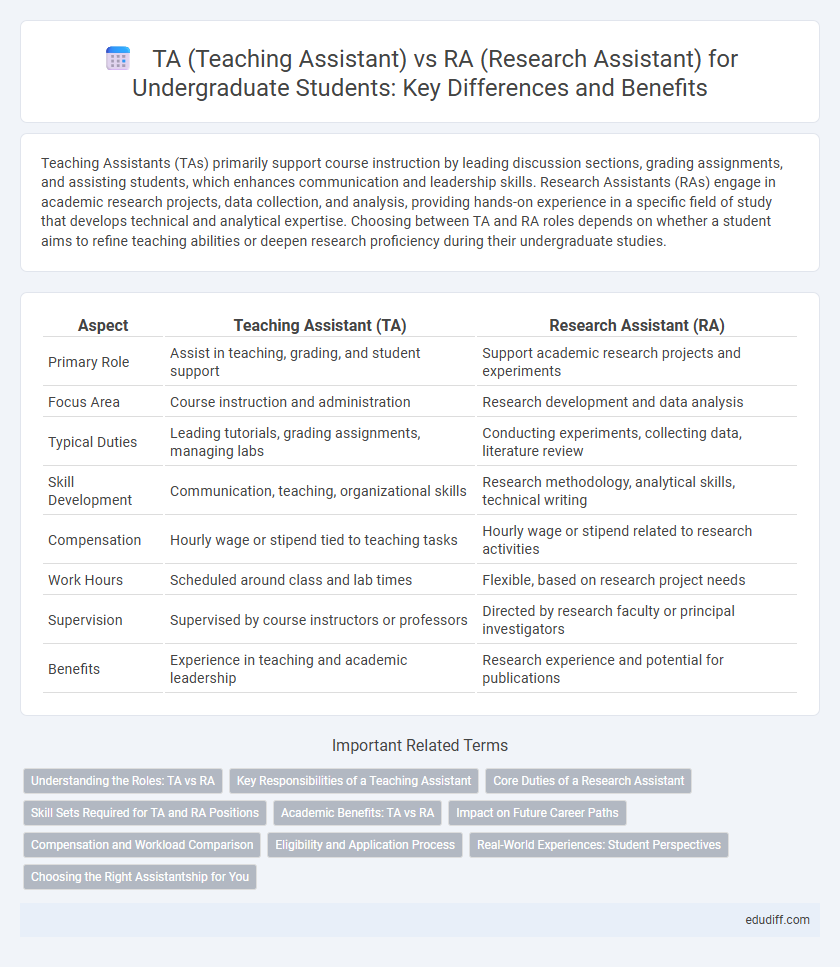Teaching Assistants (TAs) primarily support course instruction by leading discussion sections, grading assignments, and assisting students, which enhances communication and leadership skills. Research Assistants (RAs) engage in academic research projects, data collection, and analysis, providing hands-on experience in a specific field of study that develops technical and analytical expertise. Choosing between TA and RA roles depends on whether a student aims to refine teaching abilities or deepen research proficiency during their undergraduate studies.
Table of Comparison
| Aspect | Teaching Assistant (TA) | Research Assistant (RA) |
|---|---|---|
| Primary Role | Assist in teaching, grading, and student support | Support academic research projects and experiments |
| Focus Area | Course instruction and administration | Research development and data analysis |
| Typical Duties | Leading tutorials, grading assignments, managing labs | Conducting experiments, collecting data, literature review |
| Skill Development | Communication, teaching, organizational skills | Research methodology, analytical skills, technical writing |
| Compensation | Hourly wage or stipend tied to teaching tasks | Hourly wage or stipend related to research activities |
| Work Hours | Scheduled around class and lab times | Flexible, based on research project needs |
| Supervision | Supervised by course instructors or professors | Directed by research faculty or principal investigators |
| Benefits | Experience in teaching and academic leadership | Research experience and potential for publications |
Understanding the Roles: TA vs RA
Teaching Assistants (TAs) primarily support undergraduate courses by leading discussion sections, grading assignments, and assisting professors with instructional duties, enhancing classroom learning experiences. Research Assistants (RAs) focus on conducting academic research, performing experiments, data analysis, and contributing to scholarly publications under faculty supervision. Both roles offer valuable skill development, but TAs emphasize teaching and communication, while RAs concentrate on research methodology and knowledge advancement.
Key Responsibilities of a Teaching Assistant
Teaching Assistants (TAs) primarily support undergraduate education by leading discussion sections, grading assignments, and facilitating classroom activities. They assist professors in managing course logistics and provide academic support during office hours to clarify lecture materials. Their role centers on enhancing students' understanding and engagement with the curriculum.
Core Duties of a Research Assistant
Research Assistants in undergraduate programs primarily focus on conducting experiments, collecting and analyzing data, and supporting faculty-led research projects. Their core duties include literature review, developing methodologies, and synthesizing research findings into reports or presentations. Unlike Teaching Assistants who assist with instructional support and grading, Research Assistants contribute directly to advancing academic knowledge through hands-on research activities.
Skill Sets Required for TA and RA Positions
Teaching Assistant positions demand strong communication skills, patience, and the ability to explain complex concepts clearly to undergraduate students. Research Assistant roles require proficiency in data analysis, experimental design, and technical expertise relevant to the specific research field. Both positions benefit from time management skills, but TAs emphasize instructional abilities while RAs prioritize analytical and laboratory competencies.
Academic Benefits: TA vs RA
Teaching Assistants (TAs) enhance communication and leadership skills by facilitating lectures, grading, and interacting with students, which improves pedagogical knowledge. Research Assistants (RAs) gain hands-on experience in experimental design, data analysis, and academic publishing, directly contributing to scholarly expertise. Both roles strengthen a student's academic profile, but TAs focus on teaching proficiency while RAs emphasize research skills and subject-matter specialization.
Impact on Future Career Paths
Teaching Assistants (TAs) develop strong communication, leadership, and instructional skills that are highly valued in education, academia, and roles requiring public engagement. Research Assistants (RAs) gain expertise in experimental design, data analysis, and academic research, which are critical for careers in scientific research, industry R&D, and graduate studies. The choice between TA and RA positions influences future career trajectories by building distinct skill sets aligned with either teaching-oriented or research-intensive professions.
Compensation and Workload Comparison
Teaching Assistants (TAs) typically receive compensation based on hourly wages or stipends linked to instructional duties such as grading and leading discussion sections, while Research Assistants (RAs) often obtain funding through research grants with stipends reflecting research contribution and project scope. Workload for TAs usually involves fixed weekly hours centered on classroom support, whereas RAs may experience variable hours depending on research deadlines and experiments. Compensation packages for RAs can be higher due to specialized skills and grant availability, but TAs have more structured schedules promoting consistent time commitments.
Eligibility and Application Process
Undergraduate Teaching Assistants (TAs) typically need to have completed foundational courses in the subject they wish to assist with and maintain a minimum GPA, often around 3.0, while Research Assistants (RAs) are usually selected based on prior research experience or relevant coursework in the research area. TA application processes often require submitting an application through the department, including transcripts and sometimes an interview, whereas RA applications may involve directly contacting faculty members with research interests, providing a resume, and discussing specific projects. Deadlines for TA roles are generally aligned with the academic semester start, while RA opportunities can be more flexible but competitive, often dependent on available funding and ongoing research projects.
Real-World Experiences: Student Perspectives
Teaching Assistants (TAs) gain real-world experience by developing communication and leadership skills through direct interaction with undergraduate students and classroom management. Research Assistants (RAs) immerse themselves in hands-on research projects, enhancing analytical abilities and contributing to academic publications or presentations. Students often find TAs improve their collaborative and pedagogical expertise, while RAs provide deeper exposure to specialized knowledge and innovative problem-solving in their fields.
Choosing the Right Assistantship for You
Choosing between a Teaching Assistant (TA) and a Research Assistant (RA) depends on your academic goals and interests. TAs gain valuable experience in communication and pedagogy by leading discussions, grading, and assisting professors with coursework, enhancing skills useful for education-focused careers. RAs contribute to research projects, often collaborating on data collection, analysis, and publication, which is ideal for students pursuing graduate studies or careers in research-intensive fields.
TA (Teaching Assistant) vs RA (Research Assistant) Infographic

 edudiff.com
edudiff.com